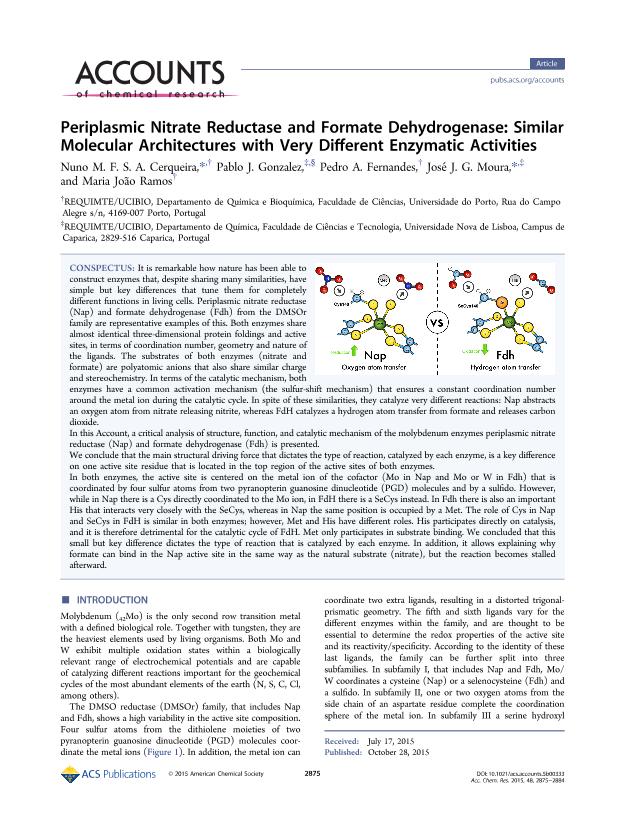Mostrar el registro sencillo del ítem
dc.contributor.author
Cerqueira, Nuno M. F. S. A.
dc.contributor.author
González, Pablo Javier

dc.contributor.author
Fernandes, Pedro A.
dc.contributor.author
Moura, José J. G.
dc.contributor.author
Ramos, Maria João
dc.date.available
2019-06-21T14:41:54Z
dc.date.issued
2015-10
dc.identifier.citation
Cerqueira, Nuno M. F. S. A.; González, Pablo Javier; Fernandes, Pedro A.; Moura, José J. G.; Ramos, Maria João; Periplasmic Nitrate Reductase and Formate Dehydrogenase: Similar Molecular Architectures with Very Different Enzymatic Activities; American Chemical Society; Accounts of Chemical Research; 48; 11; 10-2015; 2875-2884
dc.identifier.issn
0001-4842
dc.identifier.uri
http://hdl.handle.net/11336/78633
dc.description.abstract
It is remarkable how nature has been able to construct enzymes that, despite sharing many similarities, have simple but key differences that tune them for completely different functions in living cells. Periplasmic nitrate reductase (Nap) and formate dehydrogenase (Fdh) from the DMSOr family are representative examples of this. Both enzymes share almost identical three-dimensional protein foldings and active sites, in terms of coordination number, geometry and nature of the ligands. The substrates of both enzymes (nitrate and formate) are polyatomic anions that also share similar charge and stereochemistry. In terms of the catalytic mechanism, both enzymes have a common activation mechanism (the sulfur-shift mechanism) that ensures a constant coordination number around the metal ion during the catalytic cycle. In spite of these similarities, they catalyze very different reactions: Nap abstracts an oxygen atom from nitrate releasing nitrite, whereas FdH catalyzes a hydrogen atom transfer from formate and releases carbon dioxide. In this Account, a critical analysis of structure, function, and catalytic mechanism of the molybdenum enzymes periplasmic nitrate reductase (Nap) and formate dehydrogenase (Fdh) is presented. We conclude that the main structural driving force that dictates the type of reaction, catalyzed by each enzyme, is a key difference on one active site residue that is located in the top region of the active sites of both enzymes. In both enzymes, the active site is centered on the metal ion of the cofactor (Mo in Nap and Mo or W in Fdh) that is coordinated by four sulfur atoms from two pyranopterin guanosine dinucleotide (PGD) molecules and by a sulfido. However, while in Nap there is a Cys directly coordinated to the Mo ion, in FdH there is a SeCys instead. In Fdh there is also an important His that interacts very closely with the SeCys, whereas in Nap the same position is occupied by a Met. The role of Cys in Nap and SeCys in FdH is similar in both enzymes; however, Met and His have different roles. His participates directly on catalysis, and it is therefore detrimental for the catalytic cycle of FdH. Met only participates in substrate binding. We concluded that this small but key difference dictates the type of reaction that is catalyzed by each enzyme. In addition, it allows explaining why formate can bind in the Nap active site in the same way as the natural substrate (nitrate), but the reaction becomes stalled afterward.
dc.format
application/pdf
dc.language.iso
eng
dc.publisher
American Chemical Society

dc.rights
info:eu-repo/semantics/openAccess
dc.rights.uri
https://creativecommons.org/licenses/by-nc-sa/2.5/ar/
dc.subject
Molibdeno
dc.subject
Nitrato Reductasa
dc.subject
Formato Deshidrogenasa
dc.subject
Dft
dc.subject.classification
Otras Ciencias Biológicas

dc.subject.classification
Ciencias Biológicas

dc.subject.classification
CIENCIAS NATURALES Y EXACTAS

dc.title
Periplasmic Nitrate Reductase and Formate Dehydrogenase: Similar Molecular Architectures with Very Different Enzymatic Activities
dc.type
info:eu-repo/semantics/article
dc.type
info:ar-repo/semantics/artículo
dc.type
info:eu-repo/semantics/publishedVersion
dc.date.updated
2019-05-27T19:31:51Z
dc.journal.volume
48
dc.journal.number
11
dc.journal.pagination
2875-2884
dc.journal.pais
Estados Unidos

dc.journal.ciudad
Washington DC
dc.description.fil
Fil: Cerqueira, Nuno M. F. S. A.. Universidad de Porto; Portugal
dc.description.fil
Fil: González, Pablo Javier. Consejo Nacional de Investigaciones Científicas y Técnicas. Centro Científico Tecnológico Conicet - Santa Fe; Argentina. Universidade Nova de Lisboa; Portugal. Universidad Nacional del Litoral. Facultad de Bioquímica y Ciencias Biológicas. Departamento de Física; Argentina
dc.description.fil
Fil: Fernandes, Pedro A.. Universidad de Porto; Portugal
dc.description.fil
Fil: Moura, José J. G.. Universidade Nova de Lisboa; Portugal
dc.description.fil
Fil: Ramos, Maria João. Universidad de Porto; Portugal
dc.journal.title
Accounts of Chemical Research

dc.relation.alternativeid
info:eu-repo/semantics/altIdentifier/doi/http://dx.doi.org/10.1021/acs.accounts.5b00333
dc.relation.alternativeid
info:eu-repo/semantics/altIdentifier/url/https://pubs.acs.org/doi/10.1021/acs.accounts.5b00333
Archivos asociados
